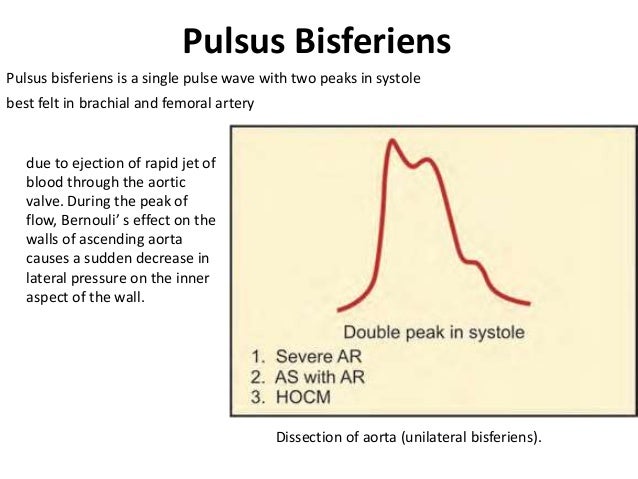Pulsus bisferiens is the exception, however, as it is most easily palpated in the peripheral arterial system, e.g. Dogtemplatesdaruma fields saddlery. The radial artery. Discover the world's research 20+ million members. SceeU defines the pulsus bisferiens as follows: quotBoth percussion and tidal waves are well represented, but the latter, instead or being rounded and sustained, forms a sharp angle. Moreover, the second wave begins low and the two waves reach the same level, or nearly so. Meanings for pulsus bisferiens Double systolic pulsation due to mixed aortic valve disease or sever aortic regurgitation It is a medical condition that causes severe pulsations in the aortic valve. Bisferiens does not consist oftwo separate waves but ofa single wave split by a markedVenturi effect-the quies media of Galen. As the pulsus bisferiens indicates mild aortic stenosis with significant regurgitation, its presence is a contra-indication to aortic valvotomy./. 'V 6v 'V.P rlptx PA A NJ 'y Ni 523 so 0 copyright.
| Pulsus bisferiens | |
|---|---|
| Other names | Bisferious pulse, biphasic pulse |
| Specialty | Cardiology |
Pulsus bisferiens, also known as biphasic pulse, is an aortic waveform with two peaks per cardiac cycle, a small one followed by a strong and broad one.[1] It is a sign of problems with the aorta, including aortic stenosis and aortic regurgitation, as well as hypertrophic cardiomyopathy causing subaortic stenosis.[1]


Pathogenesis[edit]
In hypertrophic cardiomyopathy, there is narrowing of the left ventricular outflow tract (LVOT) due to hypertrophy of the interventricular septum. During systole, the narrowing of the LVOT creates a more negative pressure due to the Venturi effect and sucks in the anterior mitral valve leaflet. This creates a transient occlusion of the LVOT, causing a midsystolic dip in the aortic waveform. Towards the end of systole, the ventricle is able to overcome the obstruction to cause the second rise in the aortic waveform.[2]
In severe aortic regurgitation, additional blood reenters the left ventricle during diastole. This added volume of blood must be pumped out during ventricular systole. Persuasive essaymr. beckers classroom. The rapid flow of blood during systole is thought to draw the walls of the aorta together due to the Venturi effect, temporarily decreasing blood flow during midsystole.[2]
A recent paper theorized that an alternative explanation for pulsus bisferiens may be due to a forward moving suction wave occurring during mid-systole.[3]
References[edit]
- ^ abRiojas CM, Dodge A, Gallo DR, White PW (January 2016). 'Aortic Dissection as a Cause of Pulsus Bisferiens: A Case Report and Review'. Annals of Vascular Surgery. 30: 305.e1–5. doi:10.1016/j.avsg.2015.07.026. PMID26520426.
- ^ abMcGee SR (2018). 'Chapter 15: Pulse Rate and Contour'. Evidence-based physical diagnosis (Fourth ed.). Philadelphia, PA: Elsevier. pp. 95–108. ISBN978-0-323-50871-1. OCLC959371826.
- ^Chirinos JA, Akers SR, Vierendeels JA, Segers P (March 2018). 'A Unified Mechanism for the Water Hammer Pulse and Pulsus Bisferiens in Severe Aortic Regurgitation: Insights from Wave Intensity Analysis'. Artery Research. 21: 9–12. doi:10.1016/j.artres.2017.12.002. PMC5863934. PMID29576810.
External links[edit]
| Classification |
|
|---|
Pulsus Bisferiens Vs Dicrotic Pulse
